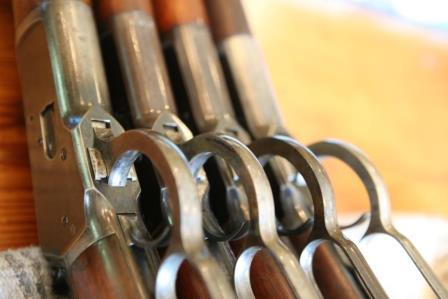I recently looked at an antique Winchester model 1892. It was an interesting gun in 44-40 with a half round barrel. Both the receiver and barrel had proof marks on them and the barrel has an address that is from a later time frame….maybe, 1908 or so.
I sent in to the museum for the letter information on it before buying it and I was quite surprised to learn that it letters as a 32-20. What do you make of this? The gun is not a high condition gun and it looks legit…..
Anyone that knows anything about the 1892 model, should know that it is virtually impossible to change a .44 to a .32. Winchester would never have done this, simply because it was cost prohibitive. The factory was very contious of the fact that their customers trusted them to make a decision that would be of benefit to the customer as far as rework was concerned. I dought they would think changing a .44 to a .32 would benefit the customer financially. My guess is that either the researcher at the museum made a mistake or the original entry in the ledger was a mistake from the get go.
sb said
I recently looked at an antique Winchester model 1892. It was an interesting gun in 44-40 with a half round barrel. Both the receiver and barrel had proof marks on them and the barrel has an address that is from a later time frame….maybe, 1908 or so.I sent in to the museum for the letter information on it before buying it and I was quite surprised to learn that it letters as a 32-20. What do you make of this? The gun is not a high condition gun and it looks legit…..
Hello SB,
What is the serial number of the rifle? Can you post or send me some images of the gun and all of the stamped writing on it?
Michael

Model 1892 / Model 61 Collector, Research, Valuation
win4575 said
Anyone that knows anything about the 1892 model, should know that it is virtually impossible to change a .44 to a .32. Winchester would never have done this, simply because it was cost prohibitive. The factory was very contious of the fact that their customers trusted them to make a decision that would be of benefit to the customer as far as rework was concerned. I dought they would think changing a .44 to a .32 would benefit the customer financially. My guess is that either the researcher at the museum made a mistake or the original entry in the ledger was a mistake from the get go.
It is the opposite in this case… a 32 WCF was possibly changed to a 44 WCF, and that is certainly possible if someone was intent on doing it.
Bert
WACA Historian & Board of Director Member #6571L

1 Guest(s)


 Log In
Log In Members
Members Home
Home

 Add Reply
Add Reply Add Topic
Add Topic Offline
Offline



 Online
Online


